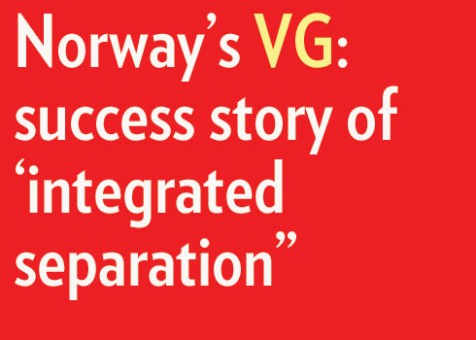
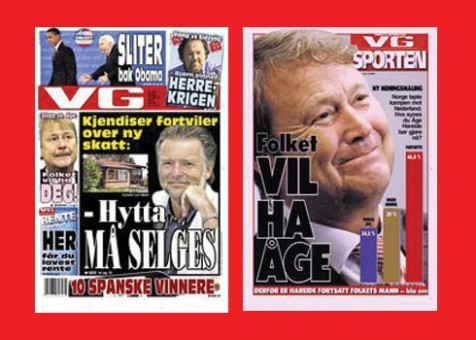
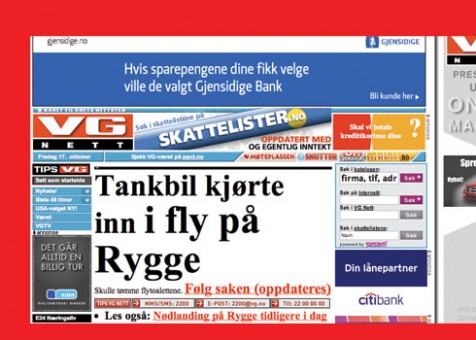
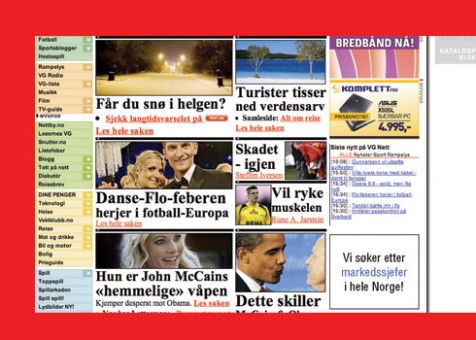
Making a case for quality journalism
Torry Pedersen’s keynote here presented an incredibly successful story of how a traditional newspaper company went multimedia, increasing profits, diversifying, and attracting new audiences in the process.
Pedersen took a look at the description of his speech in the conference program and commented on it: “I see that we are presented as ‘the enormously successful newspaper company.’ Well, we are, but these are challenging times, what I would call a hurricane category five.”
However, there is no doubt that VG of Norway is the one media company that most Europeans turn their attention to when they wish to study a successful operation, one where print and online compliment each other, and where the profit lines show arrows pointing up.
Quality journalism is the key
Regardless of the medium, don’t cut down on your ability to produce the best quality journalism. It is all about content first. Pedersen showed examples of investigative reports conducted by his newspaper, which succeed on line as well.
Circulation down, profits up
Indeed, like many other newspapers, the circulation of the VG has gone down by about 80000 readers over the past six years; however, profits are up 35% during the same period, thanks to diversification, creation of new products, and the ever evolving presence of a strong online edition.
Who reads in what medium
The figures in Norway are similar to what we see elsewhere:
Readers under 50 years of age have a tendency to read more online than in print; readers 50 and over continue to make the printed edition their favorite, and preference levels for print increase with older readers, those above 60 and 70. For the young, without any doubt, the online editions hold the greatest attraction.
In the newsroom: separated but united
VG has both online and print staffs on the same floor and nearby, but each medium has its own staff and focus. Coverage is streamlined so that the flow of stories, especially breaking news.
“With online there is no deadline,” Pedersen said. “We publish continuously. During a recent breaking story, we had 113 updates online before the printed newspaper carried the story the next morning.”
What can we do?
According to Pedersen:
Diversify, create new supplements.
Experiment with advertising, including customizing ads for clients who so desire.
Let each medium do what it does best.
Summary of presentations for Friday, Oct. 17, morning sessions; WAN 11tth Readership Conference
Larry Kilman, WAN’s Director of Communications and Public Affairs, summarizes highlights of each of today’s presentations in Amsterdam.
Sustaining profit in the eye of a hurricane
Torry Pederson, CEO, VG, Norway
“I think we should prepare ourselves for a hurricane, Force 5,” says Mr Pederson, reflecting the current media environment and its impact on newspapers.
He should know. A graph of VG’s print circulation decline over the past several years looks like a ski slope – it dropped 20 percent since 2002.
But, at the same time, profit increased from 270 million Norwegian krone (31 million euros) to 365 million krone (41 million euros). Mr Pederson’s presentation focused on how the company managed to increase its profits in such difficult times.
“Out strategy has been twofold – continuous product diversification and improving production efficiency considerably,” he said.
“We have expanded our web presence, both with the main online newspaper but also by establishing a social network site. The newspaper has added a supplement on weekends, we’ve launched a magazine for personal finance – we’ve diversified our offering over the years and that’s significant.”
In addition to diversification, here are some of Mr Pederson’s key points for thriving in tough times:
– Pricing. “I think there is a lot to do in strategic pricing in newspapers,” he says. “There is a wonderful opportunity to take the right price from the market.”
– More marketing and effectiveness research. VG spends 10 million euros annually on examining its market, and uses a model that considers all possible factors that contribute to sales.
– More attention to distribution. Ensuring good product placement at sales outlet is one important focus, as is establishing new outlets. “We have to take into account that a reader of a newspaper today is taking an opportunity to relax or to be educated, so you have to be there at the time they do it. You should have the opportunity to buy a newspaper in a coffee shop, for example.”
– Good journalism that attracts attention, on all platforms. “Don’t cut down on journalistic resources to cover the important stories,” he says.
– A wide variety of advertising opportunities for both the big spenders and the small ones. “To work a lot with space management is extremely important and will become so even more in the year’s to come.”
The Impact of Integration
Valery Levchenko, Deputy Director General, Ria Novosti, Russia
The Russian news agency Ria Novosti began working from a new integrated newsroom in January 2008. Mr Levchenko says it profoundly changed the business.
For one thing, it isn’t a news agency anymore, at least not in the classical sense. As it offers its content directly to news consumers through its digital platforms, and not only to traditional news agency customers, the focus has changed. “Instead of providing bits and pieces of news agency information, we started focusing on stories with the end user in mind,” says Mr Levchenko.
For another, “it required a change of mindset for journalists,” he says. “The idea is to think multimedia. What kind of media, what kind of combination, would suit the story best?”
That’s not as easy as it sounds. “We see a definite shortage of multimedia trained journalists,” says Mr Levchenko. More than 140 have gone through a four-day training programme, and Ria Novosti is now a partner in a multimedia journalism training programme.
Other changes include:
– A shift in corporate culture. Among other things, the average age of journalists is going down – most are in their mid- to late-twenties.
– The creation of a common technological platform and the creation of new infoscreen and mobile products.
To grow, focus on who isn’t reading the paper
Mary Lou Fulton, Vice President of Audience Development, The Bakersfield Californian, USA
Ms Fulton’s presentation showed how a relatively small regional paper can develop into a multi-media company driven by market forces and a clear strategy.
The Californian, a 59,000 circulation daily, set out five years ago to develop a broad range of new products, both print and digital. At the time, 99 percent of revenues were coming from the flagship.
In five years, it went from having no weekly newspapers to having three. From no magazines to three magazines. From one website to 11 websites. It created three subsidiaries and built its own social media software.
“Before, we focused primarily on the circulation, profitability and content of our daily newspaper,” says Ms Fulton. “The essential shift in thinking was to become interested in who was NOT reading the newspaper or advertising in it. That was a big wakeup call.
“Now are success measures are revenue and profitability, audience reach and advertiser reach. It’s not just how much money we make, but how we make our money that will be successful in the long term.”
The key elements included:
– A clear strategy – or at least a working theory – of what the future looked like.
– Marketing research to support the strategy and help determine new product launches.
– Commitment to invest in new product development – at least 1 percent of revenues each year.
– New organisational structures and approaches – experimentation is encouraged.
– Patience – but not too much.
Ms Fulton said the new products recaptured six of the eight percentage points in consumer reach lost by The Californian. It increased non-core revenue from 1 percent to 12 percent. But it hasn’t all been smooth sailing – not all the products are consistently profitably, the success has been greater with consumers than with advertisers, and the company needs to develop a greater focus on new revenue models and sales approaches.
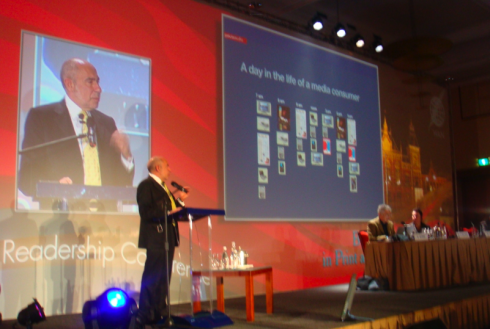
Tips for publishing in a multi-platform environment
Mario Garcia, CEO/Founder, Garcia Media, USA
Dr Garcia’s presentations are always filled with nuggets of intelligence and good advice about newspaper and website design and how they contribute to audience growth. Here are some of them:
“We have to provide intelligent navigation. Intelligent navigation is done by an editor who says, ‘the reader doesn’t have a lot of time, I’m going to tell you what’s important.’”
“We like our print and online editions to share a certain look and feel. They don’t have to be brother and sister, but they have to be first cousins. They have to be similar.”
“We deal with small images on our computers and cell phones, so why don’t we transfer that to the newspaper?”
“Newspapers are something you read. The web is something you do. Once you learn this distinction, your job and the management of the newsroom will be different. The newspaper, you read. The web, you must have some kind of activity. Online allows you to get involved.”
“Is there an end for print? No. Print is very much alive. But print will assume a different role, it will have to do a very different job.”
“There are more stories to tell, and more platforms to tell them on.”
Ensuring Newspaper Growth in Print
Sandy Romualdez, President & CEO, The Philippine Daily Inquirer
The Philippine Inquirer Group is seeing 20 percent annual circulation growth across the group. Ms Romualdez’s presentation focused on the factors that prompted such spectacular increases.
“It is our credibility that has kept the loyalty of our readers,” she says. We take our role as government watchdog very seriously. Print has the ability of pressing a story until action is taken.”
But, at the same time, “readers are time-starved,” says Ms Romualdez. “How do we make it easier for readers to put us in the proper place in their news and information value chain?”
Though the group has substantial digital growth, Ms Romualdez focused her presentation on print growth “because that’s something I don’t think is worth abandoning.” Here are some of the things the Inquirer did:
– Placing “capsules” of information beside the main articles. “In The Know” explains complex issues such as a law, or the difference between a fiscal and economic crisis. “Fast Facts” provides a list of important facts. “Inquirer Monitor” presents infographics, which are also used throughout the paper, often full-page.
– Publication of at least one heart-warming story every day because people were reading less because of the perception that newspapers carried only bad news.
– Sunday editions are more people-oriented, with stories on hopeful themes, with beautiful pictures.
– A Sunday magazine printed on coated paper instead of newsprint was seen as more valuable to readers. Circulation grew 5 percent after it was introduced – and advertising revenues grew 300 percent.
– Plentiful use of indexes and other navigation devices on the front page.
– New sections and new niche publications for overseas Filipinos, teachers and parents, children and others, and a new free commuter daily.
“You have to go where the audience is,” Ms Romualdez said.
J Ford Huffman on “Print is Eternal” posting
Leave it to my dear friend J Ford Huffman to draw up the perfect analogy after reading yesterday’s posting on William Powers’ keynote at the WAN Conference titled Print is Eternal
In case you missed the original blog posting:
https://www.garciamedia.com/blog/articles/print_is_eternal_but_it_needs_to_focus_content
I use this analogy:
Buying a book while online versus buying a book at a bookstore (or borrowing one from a library).
If you’re online at, say, Barnes & Noble, you type in the title you want and you order
the book and pay the postage.*
If you are in a bookstore you are surrounded by books with jackets and-or titles
that compel you to take second glances. En route to finding the book you want, you are intrigued by stacks and shelves of content you never knew existed or never thought you’d be interested in. You’re surrounded by visual, intellectual stimuli. You’re tempted by tables of bargain, remainder copies.
If your mission at the bookstore (or library) is one book you’re likely to spot unexpected delights: One or two others you want to read, also.
A newspaper is a “bookstore” experience: You learn about other news and other people while you are turning the pages to find what interests you. You find unexpected delights—and disasters. I always end up reading at least one story that I never intended to read. And I learn from the display advertisements, too.
Getting news online can be expedient and efficient, of course. Just not the tactile experience newsprint offers.
*By the way: Save yourself money and a book from your local bookstore.
How do you save money? When your local bookstore special-orders the book, the publisher pays
the postage. When you order a book online you pay the postage.
Knight Foundation calling
Did you know that November 1, 2008 is the last day anyone with a good
idea can submit an application to the Knight News Challenge?
The worldwide competition offers up to $5 million and seeks innovative
ideas for a digital news and information projects, including:
Improving local online news; bringing Web 2.0 tools to local
neighborhoods; publishing platforms to support conversations in
specific geographic communities.
Remember, there are just four rules for applicants to follow:
1. Use or create digital, open-source technology as the code base.
2. Use news and information to serve the public interest.
3. Benefit one or more specific geographic communities.
4. Be innovative.
For the first time, the contest offers more than fifty coaches
standing by online in the ‘“News Challenge Garage” at
garage.newschallenge.org to help innovators apply.
Last year’s winners received prizes ranging from $15,000 to $876,000.
They included individuals, philanthropic organizations and for-profit
businesses, such as the Bakersfield Californian newspaper. Ten winners
were from the United States, and six were from Canada, England,
Lithuania, South Africa, Zimbabwe and Russia.
For more information and to apply visit www.newschallenge.org.

It is Sunday, Oct. 19th, it is Amsterdam Marathon Weekend, and, although I will not run the major event, I will participate in the 7K run Sunday. Frank runs the full marathon.
TheMarioBlog posting # 123